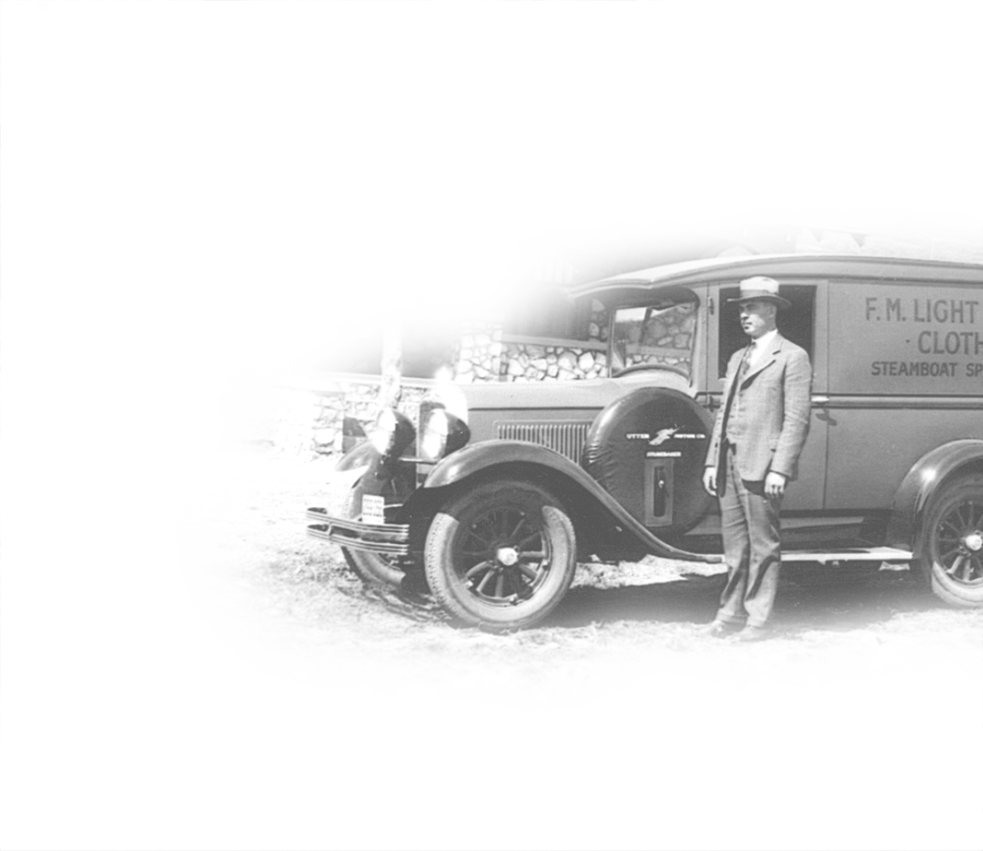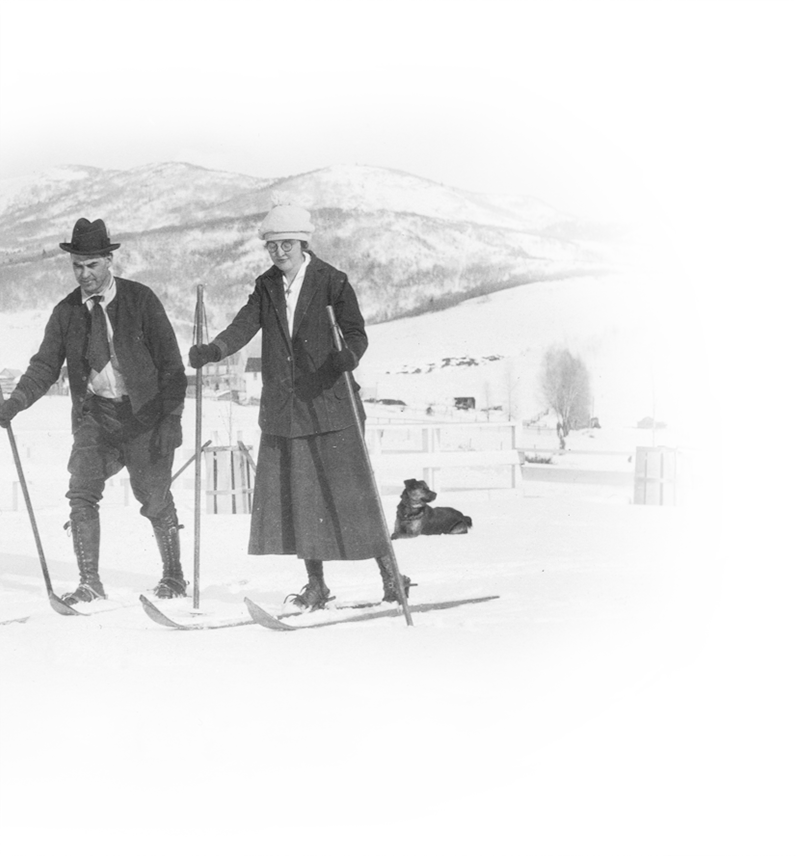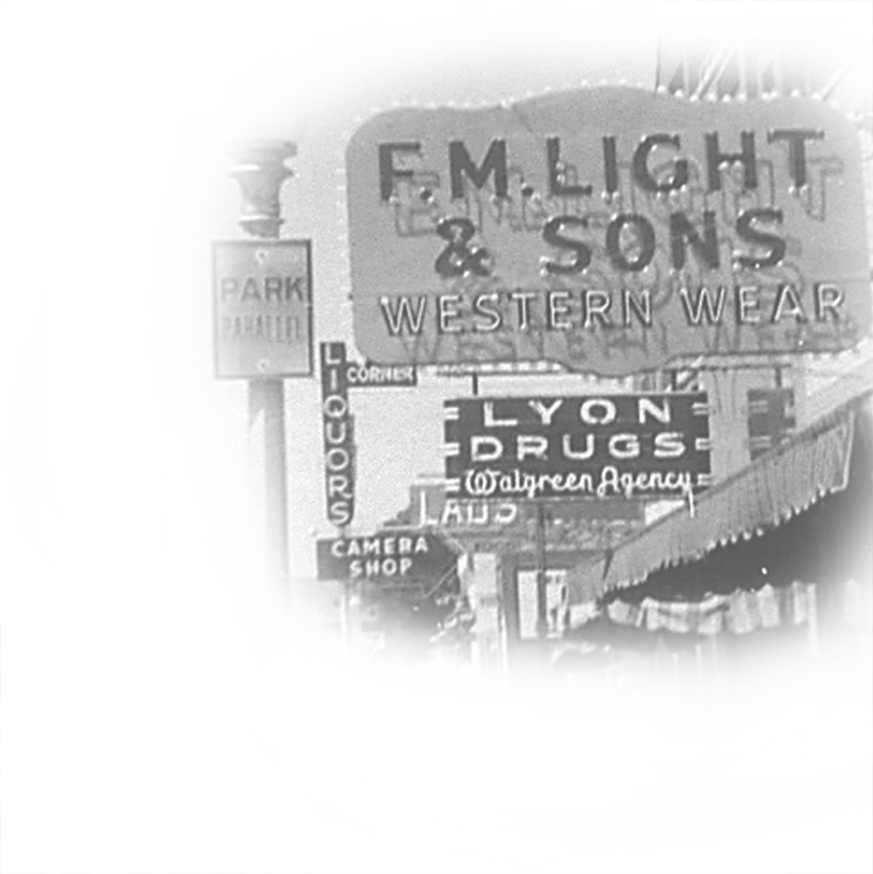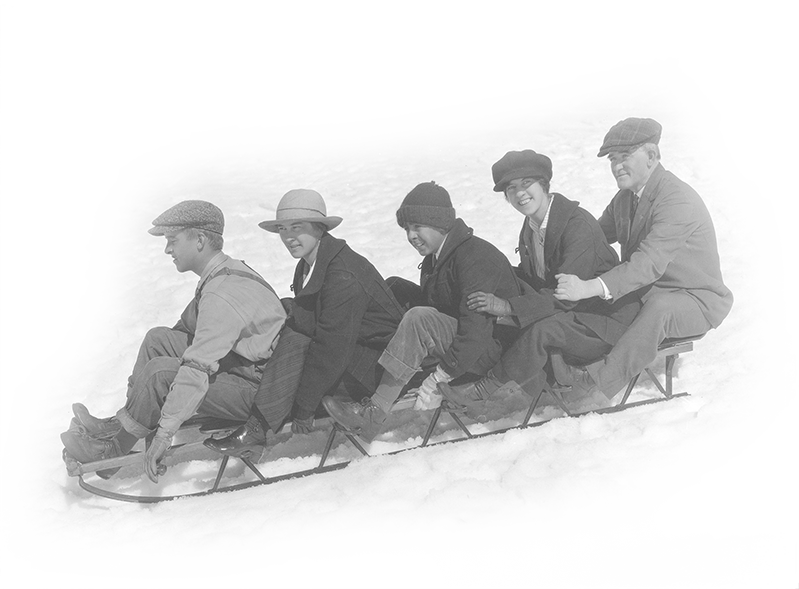History of F.M. Light & Sons
The Light Family
He came to the west by way of the Rio Grande Railroad, looking for relief from asthma—in the end he established a Steamboat Springs legacy. Thus begins the history of F.M. Light and Sons.
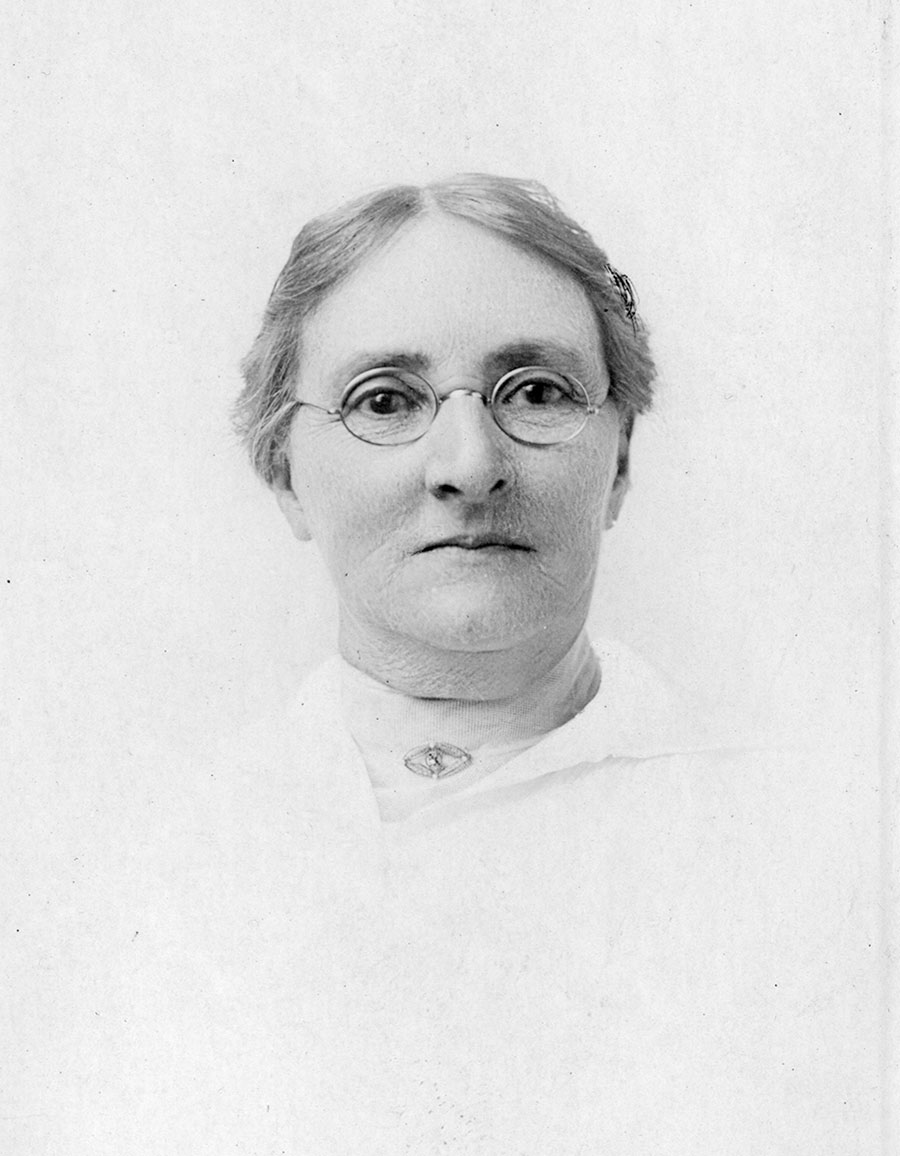
Carrie Light

Left to right: Frank, Clarence, Audrey, Marie, Hazel, Olin and Carrie. The youngest two, Wayne and Day, were not yet born.
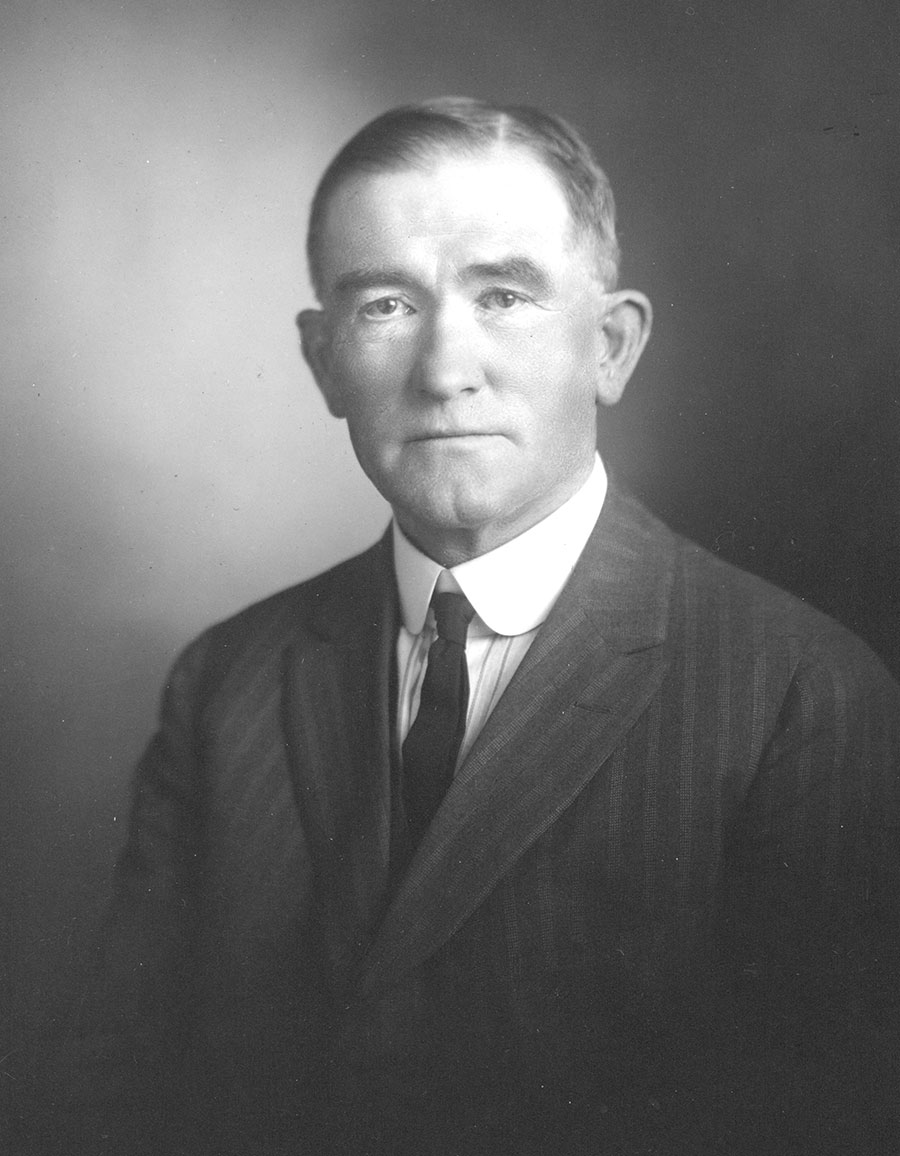
Frank M. Light
Frank M. Light stood on the train platform in Wolcott, on a cold Colorado day in April 1905, along with his wife and seven children, aged 11 months to 17.
The rugged west seemed far from the farmlands they left in Ohio. The family loaded all its belongings on the stagecoach and rode the last leg of its journey to Steamboat Springs, stopping overnight, halfway into the 80-mile trek, at the Antler’s Hotel in Yampa. It only took F.M. Light a few days to notice that Steamboat Springs lacked a men’s clothier. Encouraged by local business leaders and bankers about his prospects, Light purchased a lot in downtown Steamboat Springs. With $2,000 worth of merchandise, Light and his two sons, Olin and Clarence, opened their store for business on November 9th, 1905—just seven months after arriving in town.
F.M. Light & Sons—the store
The first day’s receipts totaled $11.50, with the second day even less.
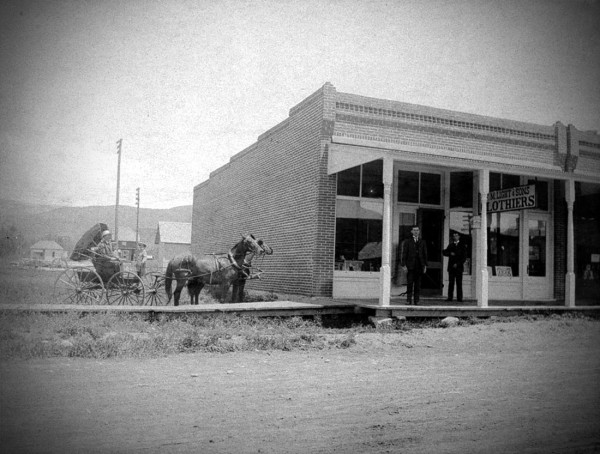 In the beginning, the store’s merchandise consisted mostly of shoes, but soon expanded to men’s fine wool suits and Stetson hats. Many of the store’s fixtures and sales cases that are still in use today came in on the stagecoach from Wolcott. Hard work, determination and a knack for marketing kept F.M. Light & Sons solvent when many stores were closing. During the lean years the Lights considered farming and teaching to make ends meet. And, in a unique marketing approach even by today’s standards (with better vehicles and roads), they obtained a loan from Milner Bank & Trust, increased their inventory and took their store on the road. Throughout the history of F.M. Light and Sons, creative thinking and imaginative marketing has been a cornerstone.
In the beginning, the store’s merchandise consisted mostly of shoes, but soon expanded to men’s fine wool suits and Stetson hats. Many of the store’s fixtures and sales cases that are still in use today came in on the stagecoach from Wolcott. Hard work, determination and a knack for marketing kept F.M. Light & Sons solvent when many stores were closing. During the lean years the Lights considered farming and teaching to make ends meet. And, in a unique marketing approach even by today’s standards (with better vehicles and roads), they obtained a loan from Milner Bank & Trust, increased their inventory and took their store on the road. Throughout the history of F.M. Light and Sons, creative thinking and imaginative marketing has been a cornerstone.
A Store on Wheels
The great depression was the cause for many broken businesses and busted banks. Rather than waiting for the farmers and ranchers to come to town, the Lights went to them.
When 1st National Bank locked its doors one morning in 1933, Light lost all of his money. With true western grit, the Light family fought for their store. Throughout the history of F.M. Light and Sons, each generation has worked hard to further the legacy. The idea of the traveling store first took shape to do just that. When the railroad came to Steamboat, F.M. Light packed up his wagon with goods and went to the workers and eventually the ranches and farms as well. Not long after, his sons Olin and Clarence were alternating weeks on the road, traveling as far north as Jackson Hole, Wyoming, west to the Utah border and south to Aspen.
“The Lights always stayed with the ranchers to better understand their customers.”

Clarence Light explained it: “a tour of the territory required a good many weeks. The usual plan was to spend a night at the ranch to get thoroughly acquainted with the family and hired men and their clothing needs, often resulting in orders of $100 or more. We always insisted on paying for our own lodging when visiting customers. We also made many lasting friendships.” Clarence was still traveling at the ripe old age of 87.
The F.M. Light salesmen would pull up in paneled trucks equipped with shelves, hangers and merchandise. Olin and Clarence would haul great suitcases heavy with samples into the ranch houses and bunkrooms. Orders were mailed into the store each day so they could be filled and shipped out to the customers immediately. For many, this was the only shopping they did all year. Within five years the traveling store represented 50 per cent of their sales. Although this was the darkest time in the history of F.M. Light and Sons, hard work and the community truly came together and the store persevered.
Marketing Comes in Yellow & Black
A huge part of the history of F.M. Light and Sons is our yellow signs. A man of advanced marketing techniques, Clarence Light launched another notable contribution that still marks Colorado landscapes today. His marketing is in the form of yellow and black roadside signs that advertise everything from cowboy hats to Navajo rugs. No matter what road you traveled into Steamboat, you knew about F.M. Light & Sons. In 1928, Clarence Light erected 260 signs in a 150-mile radius of Steamboat Springs. Eventually, that number grew to 300. Lady Bird Johnson’s highway beautification act resulted in more than a 150 signs being removed from roadways. Those that do remain standing are considered historic, with each one numbered and registered with the state of Colorado.
“To this day, each spring marks the annual sign maintenance and repair duties, now handled by the fifth generation, taking at least two men and two weeks to repair all the signs.”
Five Generations
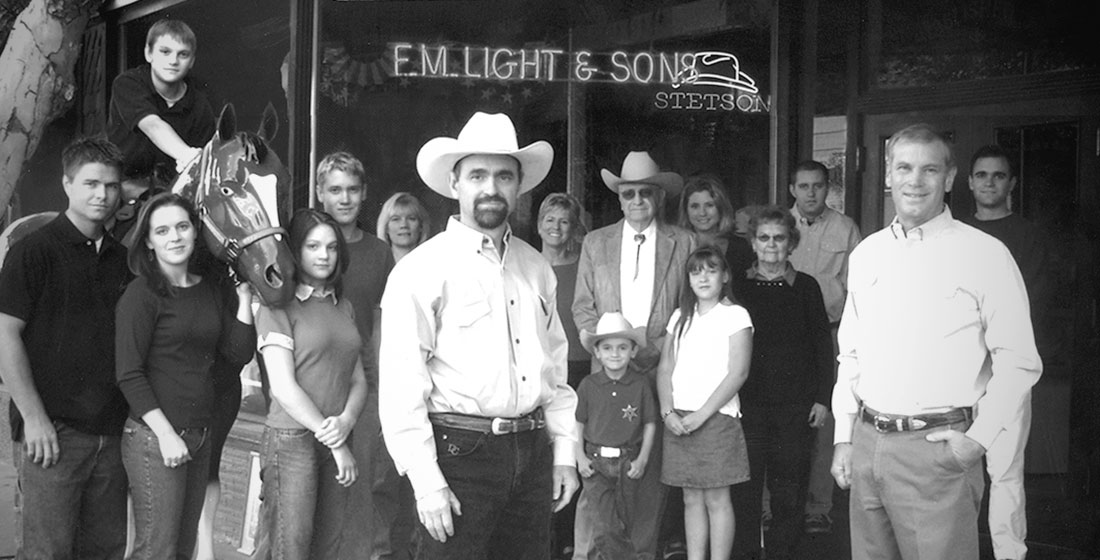
F.M. Light eventually sold his interest in the store to his sons, Clarence, Olin and E. Day. Surviving his brothers, Clarence was sole owner when he passed the store onto the third generation, his son-in-law, Lloyd Lockhart in 1963. Ty Lockhart, Lloyd’s son, the fourth generation, took over active management of the store in 1973. His brother Del joined him in 1979.
In 2012, the store was passed on to Ty’s daughter Lindsay, and her husband Chris. This means the store is now owned and operated by the 5th generation!
According to the Boston-based Family Firm Institute, only one in five companies are still in business after five years, and of those only 20 per cent will celebrate the 10 year mark.
Additionally, the institute reports that only three per cent of the family-owned businesses in the U.S. make it to the fourth generation. So, for F.M. Light & Sons to celebrate 100 years, still be owned by the same family and be located at its original site, is very rare indeed. The year 2005 marks the 100th anniversary of the F.M. Light & Sons store. A store still in the family after five generations and built on a philosophy of providing quality merchandise and fair prices. Celebrations in the community and within their store will take place all year long. The history of F.M. Light and Sons will continue on for generations. Ty Lockhart put the 100-year mark in perspective for us:
“It’s not only a celebration about our family’s history, it’s also a celebration of Steamboat Springs and the many ranching families who made their homes here.”
Frank M. Light
Some say that the store began because of sniffling. Others say it was because of sneezing. Still others say it was because of timothy and clover— turns out, they’re all right.
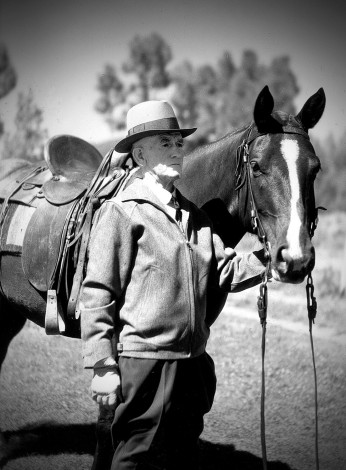 In the early part of the 20th century, in Milford Township, Ohio, a man named Francis Marion Light, and his wife, Carrie were making their living. During the winter, Francis taught as a schoolteacher. During the summer, he was a farmer.
In the early part of the 20th century, in Milford Township, Ohio, a man named Francis Marion Light, and his wife, Carrie were making their living. During the winter, Francis taught as a schoolteacher. During the summer, he was a farmer.
Light’s ancestors orginially came to the United States from Switzerland on a ship named the Winter Galley, in search of religious freedom. They were Mennonites and they used their home, which they built out of heavy limestone, as a place of worship. During the French and Indian War, the home was a refuge for as many as sixty families during an Indian siege. It became known as “Light’s Fort,” and still stands today, bearing a plaque, reading: “Home and Refuge of Johannes Leicht (John Light) – d. 1759 Light’s Fort built 1742 – Placed by Tulpehocken Chapter of the Daughters of American Colonists – Placed 1974”.
Frank’s ancestors searched for religious freedom, but Frank and Carrie Light were in desperate need of something else: clean air. A farmers life is full of dust and grass, and pollen, and Frank had asthma. His asthma was so terrible, in fact, that it impeded his work greatly. In search of fresh air, Frank considered Colorado. He made a trip in 1903 and discovered a much better climate. To make sure, he wrote to the Commercial Club of a little town called Steamboat Springs (later to become the Chamber of Commerce). His letter was handed over to Mr. Burroughs, cashier and vice president of the Milner Bank and Trust Company, asking about the year-round climate and population.
With the worsening of his health, Frank made the decision to move for the fresh Rocky Mountain air.
After selling the farm, the Light family purchased tickets on the Rio Grand Railroad to Wolcott, Colorado. How many Light’s were there? — 9
Frank and his wife Carrie had seven children: Clarence 17, Olin 15, Marie 12, Hazel 9, Audrey 7, Wayne 5 and Emerson Day, just 11 months. On March 30, 1905, the family boarded a four-horse Concord stagecoach bound for Steamboat Springs. The first stop was Yampa, where they dined on a hearty meal of elk stew and slept at the then-famous Antlers Hotel.
March 31 was a cold, blustery day.
17 year-old Clarence sat up on top of the stagecoach with the drive to catch the first glimpse of his new home. To ward off the cold, he borrowed the drivers bearskin coat. He kept questioning the driver impatiently about when he would hear the chugging of the the spring; the driver told him he would hear it the closer they got.
After finally arriving in Steamboat Springs, the Light family spent the night at the Sheridan Hotel, and met Mrs. McGittigan, the proprietor. Mrs. McGittigen was very generous to the newly-arrived family, and offered to let them use a two-room cabin she owned at the back of her hotel for their home. F.M. Light began his work immediately; he visited the town’s founder, James Crawford, and other well-established citizens. After Frank decided that he would open a men’s furnishings store, he was confident in his entrepreneurship and asked his two eldest sons, Clarence and Olin if they would rather have more education, or work with him in the store. They agreed to go into business with their father.
Frank knew he needed to start out right, so he studied various business approaches and causes of business failure. His study led him to 3 main conclusions:
- The best location for a business was 75 feet from an intersection.
- The easier it was for people to enter the store, the more customers the store would have.
- Every sale should be paid in cash. Frank decided he needed to purchase a piece of property, and began searching. He chose a spot: — 830 Lincoln Avenue
The land was bought for $1,200 on April 1, 1905, and a bricklayer was hired. The store’s developments were big news for the small town and The Routt County Sentinel reported on every step of the process, saying “Work on the Light building is progressing rapidly and is now almost ready for the inside finishing. The building has been wired throughout, not only for the interior but also for a large electric sign for the outside. Mr. Light is one of the most progressive men that has struck the town for a long time and he will certainly make a big success in business.”

Opening day was November 9, 1905, just seven months after having arrived in Steamboat Springs, F.M. Light & Sons opened its doors for business. It was a freezing cold day, with a foot of snow on the ground. Although slowly at first the store did begin to prosper and became established over time, and Frank’s goal was reached: He was able to make a living for his family and be free of his asthma in the pure Colorado air of Steamboat Springs.
This article is based on the book: F.M. Light & Sons: One Vision, One Store, 100 Years, by Annabeth Lockhart.
Great Forgery Chase
A forgery. Six-shooters. A chase. Yes, these are all elements of the story I’m about to tell. After all, F.M. Light & Sons was started in 1905. That was when the West was still a bit wild.
It was a day just like any other in Steamboat Springs, CO. But, for the two sons of Frank Light, it was a bit abnormal. Usually Clarence and Olin’s father was in the family store, but that day he had jury duty out in Hahn’s Peak. So, the two men watched faithfully over the business. A few items were sold that day and one of these transactions was paid for with a check by a Mr. Trawl. Clarence took one look at it and conferred with his brother, the check didn’t look right. So they promptly locked up the store and headed to the bank to talk to the manager, Mr. Burroughs. After analyzing the signature, Mr. Burroughs declared that a Mr. Trawl did have money in the bank.
But, the signature on the check was not his own – it was a forgery!
Clarence and Olin immediately formed their plan. They hurried back to the store, opened a drawer and secured a six-shooter pistol before locking up and heading out in search of their thief. They searched the main streets and soon found the criminal about to cross the bridge into the historic Brooklyn Neighborhood back when it was the red-light district. Before he could cross, Clarence and Olin stuck him up and demanded their money. With a six-shooter in his face, and his hands in the air, the fellow was scared half out of his mind and folded.
“Don’t shoot, please don’t shoot! I’ll give you your money!”
And give it back he did! Despite 35¢ being missing from having stopped for lunch at the Green Lantern Cafe after his crime, Clarence and Olin decided to have mercy and let the man go. They returned to the store full of triumph at their victory, proud to tell their father that they had caught the villain. All in all, they recovered $7.80.
Hear the retelling from Annabeth Light, daughter of Clarence LIght
The Horse
Anyone who has every been to F.M. Light & Sons knows about Lightning. But, do you know his history? Do you know how old he is? We’ll let him tell it:
One morning in 1949, in Denver, Colorado…
 This very nice cowboy type man came to Western Fiberglass Horse Barn where many other fiberglass horses and I were standing. Most of the horses were pinto ponies or Appaloosa. I was the only quarter horse in the bunch. Well, it just so happened this fellow was looking for a quarter horse to place on the sidewalk in front of his long established cowboy store. He said he thought people, especially people from other states and countries, would enjoy seeing a cow pony on the sidewalk. He planned to place a hand-stamped leather, western saddle on the horse over a wool saddle blanket made by the Navajo Indians. Then he would add a bridle with reins so people would see what fittings are necessary for riding a cowboy horse in the west. This man looked at every one of us very thoroughly. I could tell he knew a great deal about horses and he studied each one’s stance and the looks in each pair of eyes. I heard him briefly say he liked the color of my coat and that he had a horse about the same color as me which he rode when he went fishing up Soda Creek. I think the thing cinching his decision to take me home with him was because I looked the most authentic.
This very nice cowboy type man came to Western Fiberglass Horse Barn where many other fiberglass horses and I were standing. Most of the horses were pinto ponies or Appaloosa. I was the only quarter horse in the bunch. Well, it just so happened this fellow was looking for a quarter horse to place on the sidewalk in front of his long established cowboy store. He said he thought people, especially people from other states and countries, would enjoy seeing a cow pony on the sidewalk. He planned to place a hand-stamped leather, western saddle on the horse over a wool saddle blanket made by the Navajo Indians. Then he would add a bridle with reins so people would see what fittings are necessary for riding a cowboy horse in the west. This man looked at every one of us very thoroughly. I could tell he knew a great deal about horses and he studied each one’s stance and the looks in each pair of eyes. I heard him briefly say he liked the color of my coat and that he had a horse about the same color as me which he rode when he went fishing up Soda Creek. I think the thing cinching his decision to take me home with him was because I looked the most authentic.
Whew! Was I ever excited! I could just see that Mabelene filly snort in disgust! She was so sure she would be the chosen one. When my new owner hoisted me into the horse trailer for the drive home, he said to me, “my name is Mr. LIght and I’m naming you ‘Lightning’ after me.” I was a happy quarter horse!
Mr. Light had arranged to have a sturdy wooden base built for me to stand on and this platform was ready for me when we arrived home. It fit me perfectly. The stand had rollers on it so I would be rolled out of the cowboy store early each morning and rolled back into the store each evening. Everyday, I got to be the first thing people saw about our store when they went down Lincoln Avenue.
My favorite time was when small children came up to me and asked their parents if they could ride me. These kids seemed to think I was a real horse. After their parents lifted them into my saddle they would say, “giddyup!” Parents have always loved taking pictures of their children riding me. Mr. Light’s store has received hundreds of pictures of people, large and small, riding me and still does today.
In 1995, the Steamboat Springs City Council designated me as an historical asset because I’ve been a big part of Steamboat for so many years. This made me extremely proud.
I’ve had a couple of new coats of paint, as my old coat becomes shabby with so many people taking rides on me. I’ve also had several new saddles and bridles. They do wear out but I just keep standing around enjoying the many visitors and locals in town. I especially enjoy the Fourth of July when we celebrate the birth of our nation. I always get a special place to ride in the parade as they put me on a flatbed truck and decorate me with red, white and blue bunting. Real cowboys walk along beside me and do I ever feel special! Steamboat Springs is a wonderful place to live. I’m so happy the owner of F.M. Light & Sons chose me to come be such a big part of his legacy”
Written by Brandon Lockhart, Great-Grandson of Frank Light, and son of Annabeth Light (Frank’s Grand-Daugther)
We have a gallery of kids on Lightning browse and share your photos with us!
The Yellow Signs
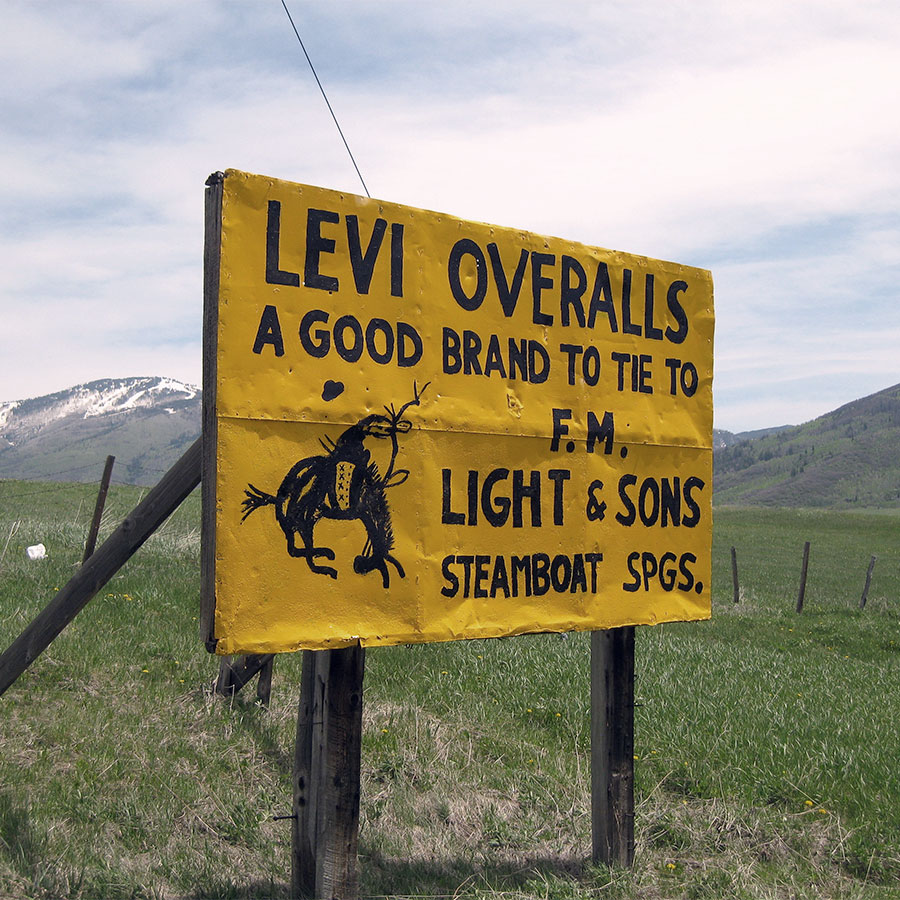
“A Good Brand to Tie To”
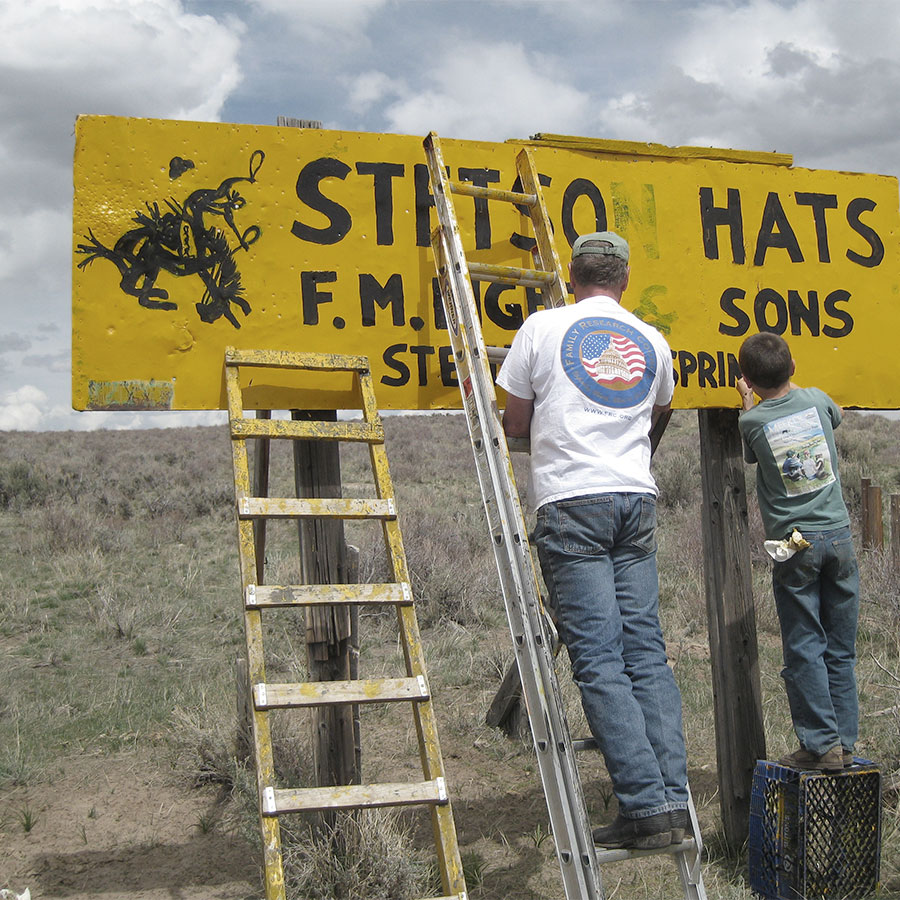
Annual Sign Painting
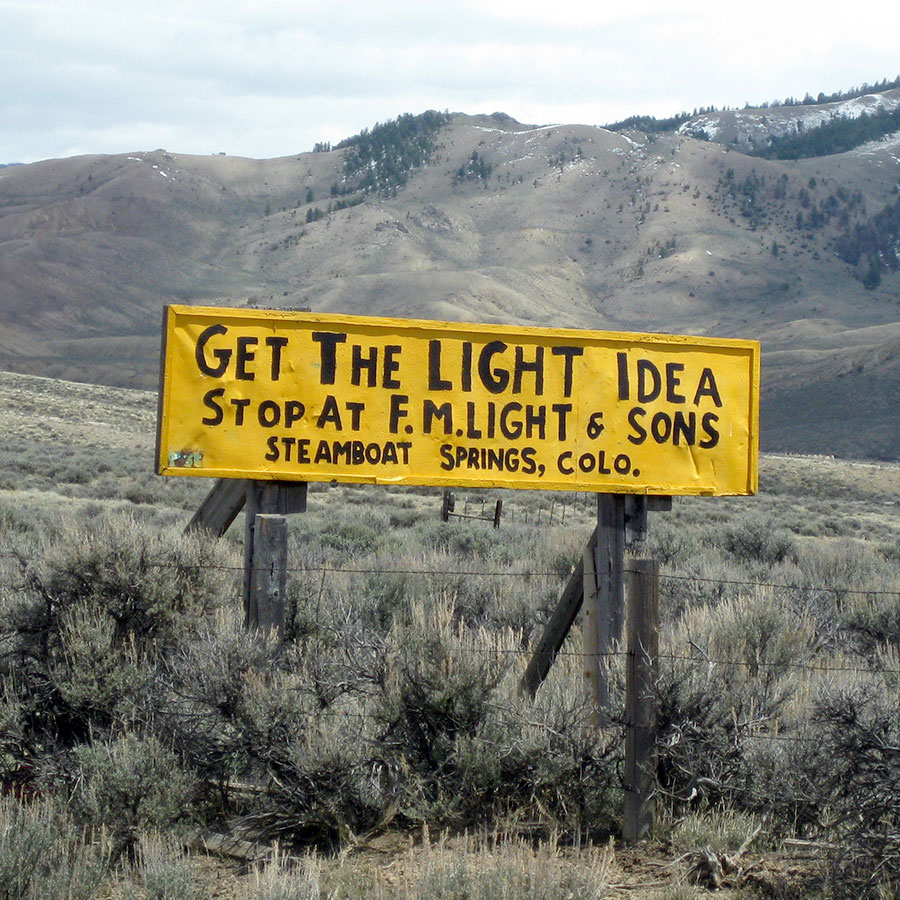
“Get the Light Idea”
How many are there? Who paints them? How old are they? You have so many questions. And it’s about time we started answering. Today, we’re going to tackle one of our most asked questions—who paints the signs?
Today, Chris and Lindsay, who is the great-great-granddaughter of Frank Light, are responsible for the upkeep. The process of caring for the signs is rather long, actually. Preparation includes loading up the truck with supplies; hammers, sledgehammer, jack, saws, levels, tape measures, nails of all sizes, ladders, crow bar, shovels, concrete, water, 2×6’s, 2×4’s, stakes, black paint, and lastly, the quintessential yellow paint. When the weather begins to warm up, they head down the road to begin annual repairs!
First, the signs must be bolstered after a lengthy, difficult winter.
The state of the support beams is sometimes quite compromised. This is because livestock enjoy rubbing up against the rough beams. This wreaks havoc and oftentimes the repair requires new lumber, rebuilding of the sign frame, and re-erecting the sign. In a high wind, it’s always a bit “touch and go.”
Secondly, the yellow background of the sign must be reapplied.
Unfortunately, the black lettering is in the way. So, it is covered by a layer or two of yellow, giving the sign a fresh glow.
Thirdly, the lettering must be repainted.
Even thought it’s straight forward, it is quite labor-intensive. We have figured that it takes approximately 30 minutes per sign f there’s a bucking horse on the sign, and two people lettering; 20 minutes per sign if there are three people lettering. All of this depends on the wind velocity. In high winds, it’s not unusual for the paint to not make it from the paint can to the sign! The old lettering shows through the freshly applied yellow paint, so it’s sort of like tracing at this point. This is the final step of sign painting, and it’s the most rewarding.
The most difficult part of the lettering is the repainting of the historic F.M. Light bucking bronco (our unofficial logo). After many repairs, the bronco becomes a bit vague. Thus, the repairers have to be quite skilled at re-drawing the horse. Sometimes there has been major damage to a sign. There are also many signs where people have decided to use them for target practice; there are bullet and shotgun pellet holes dotting many. Most of these bullet holes are over 70 years old, and today actually add to the historical significance of the signs.
Do you have a picture of the signs you want to share? Submit them using the form below!
[contact-form-7 id=”5105″ title=”Yellow Sign Pictures”]

